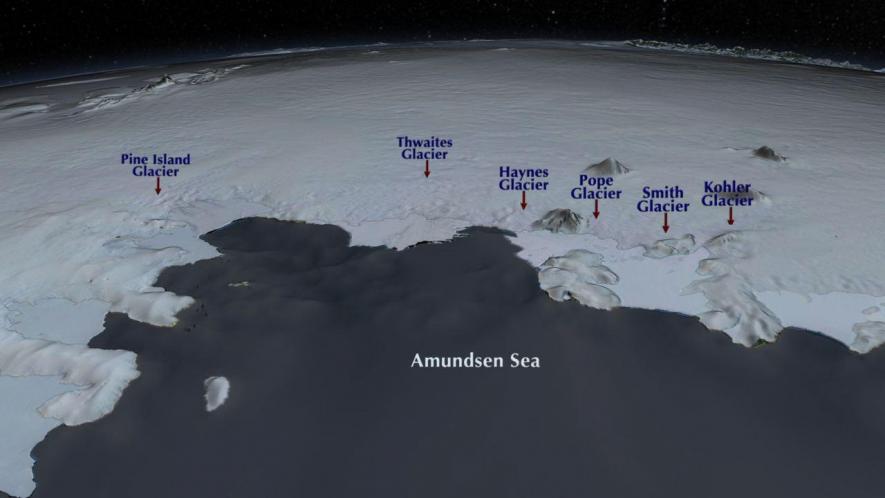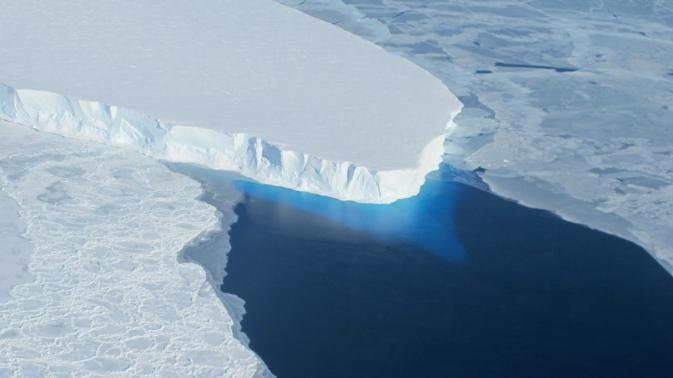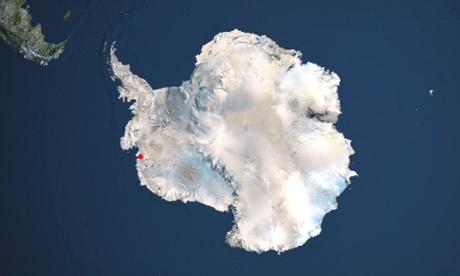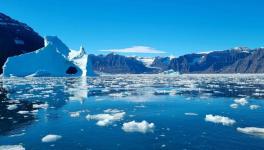The Antarctic Ice Sheet Melting Much Faster than Predicted
It is as certain as we can be in science that we will lose a major part of the Antarctic ice sheet within the next 200-900 years, leading to a devastating rise in sea level of about 4 meters. Worse, the process is now irreversible. Two separate studies, one by NASA used satellite and airborne radar data from past 40 years, and the other by European Space Agency's CryoSat2 satellite that measured the height of the glaciers, have both come to very similar conclusions. The Antarctic is losing ice rapidly from the glaciers at approximately 160 billion tonnes a year.
The Intergovernmental Panel on Climate Change (IPCC) had not taken this into account while computing the future sea level rise. A computer model study predicting the future of Antarctic glaciers from the University of Washington has also come to similar conclusions: that the Antarctic glaciers have entered into a phase of irreversible collapse and this would lead to disastrous sea level rise.
The climate change deniers had gone into a frenzy earlier with IPCC figures that indicated that atmospheric temperature increase in the last decade has been lower than in the earlier periods. IPCC had clarified that when addressing global warming, instead of short term changes in global surface temperature, we need to look more at ocean temperatures. Oceans are relatively free of local or short term effects and according to IPCC 5th Assessment Summary for Policy Makers (2013), “Ocean warming dominates the increase in energy stored in the climate system, accounting for more than 90% of the energy accumulated between 1971 and 2010 (high confidence). It is virtually certain that the upper ocean (0−700 m) warmed from 1971 to 2010”. It is precisely this warming of the ocean that is seeing the collapse of the Antarctic glaciers – it is the warm sea water from underneath that is the main cause of the glaciers melting.

Image Credit: NASA
The NASA study (a joint team from NASA and University of California, Irvine) focussed on the retreat of six glaciers in western Antarctica in the Amundsen Sea sector. Though the six glaciers contain only a fraction of the ice in the Antarctic, it is enough to cause a rise of 1 metre of the sea level around the world. The key problem with these six glaciers is that they are effectively flowing into the Amundsen Sea and are not anchored to the ground. Since a large part of these glaciers float on the sea, they are particularly vulnerable to warm ocean currents from below. This causes their thinning and consequently a retreat of the line that demarcates floating ice and grounded ice – the grounding line. This retreat of the grounding line is a significant indicator of ice melting. The study found that one of them, the Pine Island glacier's grounding line has retreated by 31km, while Thwaite glacier's grounding line retreated by nearly 14 km from 1992-2011. Eric Rignot the lead author in the NASA-UCI study said, "The collapse of this sector of West Antarctica appears to be unstoppable...The fact that the retreat is happening simultaneously over a large sector suggests it was triggered by a common cause, such as an increase in the amount of ocean heat beneath the floating sections of the glaciers. At this point, the end of this sector appears to be inevitable." In other words, it is global warming that has led to the warming of the oceans triggering the glacial collpase.

Thwaite Glacier, Image Credit: NASA
The Thwaite glacier's collapse has another consequence – it acts as a dam for the rest of western Antarctic's ice sheet. If it melts, this would accelerate the rest of the ice sheet also flowing into the ocean and then melting. Therefore, the prediction that the loss of the Western Antarctic ice sheet could lead to an increase of sea level rise by as must as 4 metres over the next few hundred years (200-900 years).

A picture of the entire Antarctic ice sheet with Thwaite glacier marked in red.
The IPCC and other predictions of sea level rise did not factor in the increased flow of glacial ice into the oceans from Antarctica and therefore underestimates – according to the NASA study – the degree of sea level rise that could take place over the next 100 years. We are therefore likely to see a seal level rise of about a metre by 2100 -- the upper end of the IPCC predictions -- changing the world's coastline completely and submerging low lying coastal lands.
The CryoSat2 satellite data is even more compelling. It is the most detailed study of the measurements of the changes in the height of the ice over virtually the whole (96%) of Antarctica. It is a far more detailed study than conducted earlier, particularly of the coastal regions, where the ice loss is the highest. It shows that the Thwaite and Pine Island glaciers are losing between 4 to 8 metres in height every year. The conclusions are very similar to the NASA study, the Thwaite and Pine Island glaciers are melting much faster than calculated earlier, as also brought out by the NASA study of grounding line retreat. The CryoSat2 study has calculated that the loss of ice every year is about 159 billion tonnes, concentrated much more in the western Antarctica where the glacial flow to the seas are compounding the problem. Significantly, the loss due to glacial melting is 31% higher in the 2010-2013 period than in the earlier 2005-2011 period.
It is not true that climate change alone is the cause of glaciers melting in western Antarctica. The rise of ocean temperature is acting on a system that also has some inherent instabilities – these glaciers are not firmly anchored onto the land which many other glaciers are. This has accelerated their flow into the surrounding sea. The underlying cause of this phenomenon is the warming of the ocean that is melting these glaciers; the rate of change is undoubtedly faster due to the instability of the glacial system.
The climate change deniers have two main lines of argument. One is that temperature rise is not taking place at all – it is only a small random variation that has no clear pattern. The second is that even if temperature rise is taking place, it is due to other reasons and not due to increased levels of greenhouse gases (mainly carbon dioxide or CO2) in the atmosphere. It is interesting to see how quickly the proponents of the first line of argument fall back on the second line of “defence” if they find temperature change difficult to contest as can be seen through the studies of glaciers melting.
The US has been the main centre of climate change deniers. They are not really contesting climate change as much as a possible lifestyle change, the consequence of accepting climate change being a reality. Do they then need to change how much energy they consume or change the way they generate electricity by burning fossil fuels? It is the opposition to both that drives the climate change denial lobby. If we could separate the two – addressing the reduction of release of greenhouse gases from that of the science of climate change – we could possibly have a more meaningful discussion. Otherwise, we get back to senior George Bush's position – American lifestyles are not open for negotiations. And then we get the whole bunch of climate change deniers whose concern is driven primarily by their need to maintain their current lifestyles.
This is the key problem today in the climate change debate. Any discussion on greenhouse gases or CO2 emissions become rapidly a discussion on energy costs. If we change to a low carbon path – a much faster induction of renewables – the cost of energy will increase. The cost of solar energy is about five times that of producing electricity by burning coal. So when the US wants to impose a low carbon path for others while retaining its current high carbon energy production system, it is seeking a market advantage for its products. That is what lies behind its insistence that per capita measure of emission is not acceptable and only cuts based on current CO2 levels are acceptable. It means that if other countries have to reach even a much lower level of per capita emissions, its energy costs will be much higher than that of the US. If any country wants to take a low carbon path unilaterally, its cost of energy will rise faster than others making its goods non-competitive in the global market. That is why the need for a global understanding and the US being a party to it as the world's largest historical emitter of CO2.
The high cost of producing electricity is by itself not such a big issue. The cost of oil has risen by almost 10 times in the last 15 years. This has not led to the collapse of the global economy; nor has it caused the automobile industry to collapse. Yes, a higher cost of electricity will have an impact on the pace of development of countries such as India or on the less economically developed countries; and it will be a heavy burden. Without getting into how this burden is to be shared, right now the world is locked into a discussion in which one rogue state – the US – refuses to take any binding global commitments to reduce its greenhouse gas emissions.
The world is therefore today locked into a path of devastating effects of climate change as we are all now being held hostage to the politics of the US. No amount of data and science appears to make any impact on the US public opinion, fed as it is by the fossil fuel lobby and Koch brothers. This, unfortunately is not just a US tragedy but a global one. The world will pay a heavy price for US intransigence and the poor – countries as well as people – will pay an even heavier one.
Disclaimer: The views expressed here are the author's personal views, and do not necessarily represent the views of Newsclick
Get the latest reports & analysis with people's perspective on Protests, movements & deep analytical videos, discussions of the current affairs in your Telegram app. Subscribe to NewsClick's Telegram channel & get Real-Time updates on stories, as they get published on our website.























